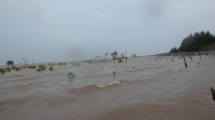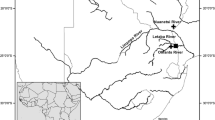Abstract
Dicrocoeliid trematodes were detected from Iwasaki’s snail-eating snake Pareas iwasakii in Iriomote Island, Okinawa Prefecture, Japan, and described as a new species Paradistomum dextra n. sp. in the present study. This new species can be distinguished from the type series of the other members of the genus based on size of eggs and morphological characteristics of body, oral and ventral suckers, and reproductive organs. However, the new species was hard to distinguish from Paradistomum megareceptaculum infecting snakes in Japan, including Iriomote Island where is the type locality of the new species, because it is closely similar to some part of the broad range of morphological variations in P. megareceptaculum. On the other hand, a partial sequence of 28S ribosomal DNA clearly distinguished these two species. Moreover, the new species’ host snake Pareas iwasakii is reported to exclusively feed on land snails while host snakes of P. megareceptaculum feed on small vertebrates, indicating that the new species is also ecologically different from P. megareceptaculum. We also redescribed P. megareceptaculum based on adults sampled in this study and past studies to record the morphological variations of this species.




Similar content being viewed by others
Data availability
The sequence datasets analyzed during the current study are available in the Genbank repository, LC798259–LC798264. The other datasets analyzed during the current study are available from the corresponding author on reasonable request.
References
Aldhoun, J., Elmahy, R., & Littlewood, D. T. J. (2018). Phylogenetic relationships within Dicrocoeliidae (Platyhelminthes: Digenea) from birds from the Czech Republic using partial 28S rDNA sequences. Parasitology Research, 117, 3619–3624. https://doi.org/10.1007/s00436-018-6062-9
Arora, S., Agarwal, M. M., & Agarwal, S. M. (1962). Studies on some intra-specific variations in Paradistomum orientalis Narain and Das collected from the liver and intestine of Calotes versicolor Daud. Pan II. (Dicrocoeliidae-Trematoda). Indian Journal of Helminthology, 14, 5−15.
Bhalerao, G. D. (1929). The genus Paradistomum in Burmese reptiles. Annals and Magazine of Natural History, 3, 412–421.
Bhalerao, G. D. (1936). Studies on the helminths of India. Trematoda I. Journal of Helminthology, 14, 163−180. https://doi.org/10.1017/S0022149X00003679
Byrd, E. E. (1949). Paradistomum samoensis n. sp., a new dicrocoeliid from Samoan lizards. Proceedings of the Helminthological Society of Washington, 16, 114−117.
Fischthal, J. H., & Kuntz, R. E. (1981). Additional records of digenetic trematodes of mammals from Taiwan. Proceed Helminthol Society of Washington, 48, 71−79. https://doi.org/10.1111/j.1463-6409.1981.tb00499.x
Furusawa, H., & Waki, T. (2024). A description of a new species of the genus Brachydistomum (Trematode, Dicrocoeliidae) from the Eurasian Tree Sparrow Passer montanus in Japan, with a report on the first intermediate host. Systematic Parasitology, 101(2), 1−14. https://doi.org/10.1007/s11230-024-10148-1
Goldberg, S. R., Bursey, C. R., & Fisher, R. N. (2005). Helminth records from eleven species of Emoia (Sauria: Scincidae) from Oceania. Pacific Science, 59, 609−614. https://doi.org/10.1353/psc.2005.0043
Hasegawa, H., & Iwatsuki, N. (1984). Parasitic helminths collected from the snake, Dinodon rufozonatus walli on Iriomote-jima Island, Okinawa, Japan. Akamata, 2, 12−17.
Herpetological Society of Japan (2021). Amphibians and Reptiles of Japan. Sunrise Publishing Co Ltd. (in Japanese)
Hoso, M. (2012). Cost of autotomy drives ontogenetic switching of anti-predator mechanisms under developmental constraints in a land snail. Proceedings of the Royal Society B: Biological Sciences, 279, 4811−4816. https://doi.org/10.1098/rspb.2012.1943
Hoso, M., & Hori, M. (2006). Identification of molluscan prey from feces of Iwasaki's slug snake, Pareas iwasakii. Herpetological Review, 37, 174−176.
Hoso, M. & Kakegawa, T. (2018). Pareas iwasakii (Iwasaki's snail-eating snake). Diet. Herpetological Review, 49, 760−761.
Hoso, M. & Shimatani, I. K. (2020). Life-history modeling reveals the ecological and evolutionary significance of autotomy. The American Naturalist, 196, 690–703. https://doi.org/10.1086/711311
ICZN. (2012). International Commission on Zoological Nomenclature: Amendment of articles 8, 9, 10, 21 and 78 of the International Code of Zoological Nomenclature to expand and refine methods of publication. Bulletin of Zoological Nomenclature, 69, 161–169.
Kagei, N. (1972). Helminth fauna of reptiles in Japan I. The Snake, 4, 114−117.
Kifune, T., Terasaki, K., & Iwata, K. (1977). New distributional and host records of two trematode parasites of cold-blooded animals in the western Japan. Medical Bulletin of Fukuoka University, 4, 245−249.
Kumar, S., Stecher, G., Li, M., Knyaz, C., & Tamura, K. (2018). MEGA X: Molecular Evolutionary Genetics Analysis across computing platforms. Molecular Biology and Evolution, 35, 1547-1549. https://doi.org/10.1093/molbev/msy096
MacCallum, G. A. (1921). Studies in helminthology. Zoopathologica, 1(6), 137−284
Ministry of the Environment. (2019). Announcement of Ministry of the Environment Red List 2019. Retrieved January 26, 2024, from https://www.env.go.jp/press/106383.html (in Japanese)
Miura, O., Kuris, A. M., Torchin, M. E., Hechinger, R. F., Dunham, E. J., & Chiba, S. (2005). Molecular-genetic analyses reveal cryptic species of trematodes in the intertidal gastropod, Batillaria cumingi (Crosse). International Journal for Parasitology, 35, 793−801. https://doi.org/10.1016/j.ijpara.2005.02.014
Nakao, M., Waki, T., Sasaki, M., Anders, J. L., Koga, D., & Asakawa, M. (2017). Brachylaima ezohelicis sp. nov. (Trematoda: Brachylaimidae) found from the land snail Ezohelix gainesi, with a note of an unidentified Brachylaima species in Hokkaido, Japan. Parasitology International, 66, 240–249. https://doi.org/10.1016/j.parint.2017.01.015
Nei, M., & Kumar, S. (2000). Molecular Evolution and Phylogenetics. Oxford University Press.
Pojmańska, T. (2008). Family Dicrocoeliidae Looss, 1899. In: Bray RA, Gibson DI, & Jones A (eds.), Keys to the Trematoda, Volume 3. CABI. Wallingford UK. pp. 233–260.
Simha, S. S. (1958). Studies on the trematode parasites of reptiles found in Hyderabad State. Zeitschrift für Parasitenkunde, 18, 161−218. https://doi.org/10.1007/BF00259193
Sitko, J., Okulewicz, J., & Noga, L. (2000). Variability and systematic status of Lutztrema attenuatum (Dujardin, 1845) comb. n. (Trematoda: Dicrocoeliidae) parasitizing passeriform birds. Helminthologia, 37, 97–111.
Tamura, M. (1941). New snake trematodes of the genera Allopharynx and Dicrocoelium. Journal of Science of Hiroshima. Series B, Division 1. Zoology, 1, 9, 197−207.
Timon-David, J., & Timon-David, P. (1967). Contribution to the knowledge of the biology of the Dicrocoeliidae (Trematoda, Digenea). Experimental studies on the life cycle of Paradistomum mutabile (Molin), parasite of the biliary tract of Lacerta muralis (Laurenti). Annales de Parasitologie Humaine et Comparée, 42, 187–206.
Tkach, V. V., Kudlai, O., & Kostadinova, A. (2016). Molecular phylogeny and systematics of the Echinostomatoidea Looss, 1899 (Platyhelminthes: Digenea). International Journal for Parasitology, 46, 171−185. https://doi.org/10.1016/j.ijpara.2015.11.001
Toriba, M., & Matsuo, K. (2011). The trematodes parasitic in the snales of Japan. Bulletin of the Herpetological Society of Japan, 1, 26−31.
Tubangui, M. A., & Masiluñgan, V. A. (1935). Trematode parasites of Philippine vertebrates, VII. Additional records of new species. Philippine Journal of Science, 58, 435−444.
Uchida, A., Uchida, K., & Itagaki, H. (1977). Studies on the reptile endoparasites in Japan (I). Digenetic trematodes from snakes, Rhabdophis tigrinus and Trimersurus okinavensis. The Snake, 9, 5−7. (in Japanese)
Wu, B. H., Xida, S., & Song, C. C. (1991). Fauna of Zhejiang (Trematoda). Zhejiang Science and Technology Publishing House.
Yamaguti, S. (1971). Synopsis of Digenetic Trematodes of Vertebrates. Vols I and II. Keigaku Publishing.
Yomeishu Seizo (1999). Ecology and Artificial Propagation of the Mamushi. Yomeishu Shuzo Co. Ltd. (in Japanese)
Acknowledgements
The authors are grateful to Takuo Akuzawa, Shinichiro Mukai, Takashi Nagamine and Yumiko Nakaya for helping our research.
Author information
Authors and Affiliations
Contributions
T. W., M. H., M. N., and M. U. wrote the main manuscript text. M. H. and M. N. sampled hosts and trematodes. T. W. and H. S. prepared figures, tables and online resources. M. N. and H. S. prepared trematode specimens for observations.
Corresponding author
Ethics declarations
Competing interests
The authors declare no competing interests.
Additional information
Publisher's Note
Springer Nature remains neutral with regard to jurisdictional claims in published maps and institutional affiliations.
This article was registered in the Official Register of Zoological Nomenclature (ZooBank) as 289A6D01-C75D-40EA-BA32-07A70C3BD35F. This article was published as an Online First article on the online publication date shown on this page. The article should be cited by using the doi number. This is the Version of Record.
Supplementary Information
Below is the link to the electronic supplementary material.
Rights and permissions
Springer Nature or its licensor (e.g. a society or other partner) holds exclusive rights to this article under a publishing agreement with the author(s) or other rightsholder(s); author self-archiving of the accepted manuscript version of this article is solely governed by the terms of such publishing agreement and applicable law.
About this article
Cite this article
Waki, T., Hoso, M., Nitta, M. et al. A new species of the genus Paradistomum (Platyhelminthes: Trematoda) from Iwasaki’s snail-eating snake Pareas iwasakii, with a note on morphological variations of Paradistomum megareceptaculum (Tamura, 1941). Syst Parasitol 101, 41 (2024). https://doi.org/10.1007/s11230-024-10164-1
Received:
Accepted:
Published:
DOI: https://doi.org/10.1007/s11230-024-10164-1




